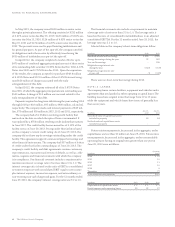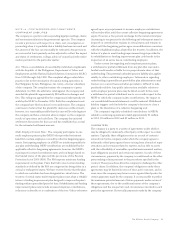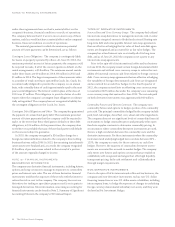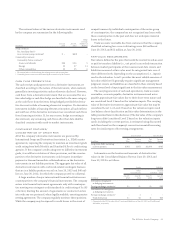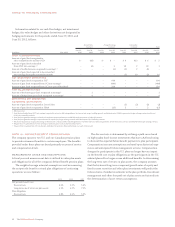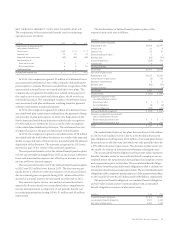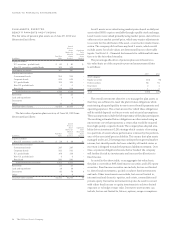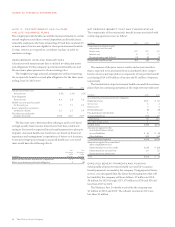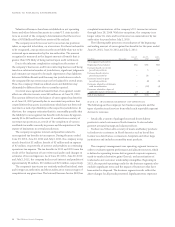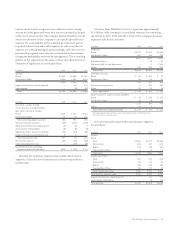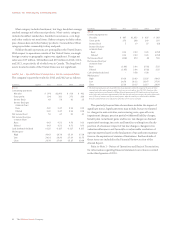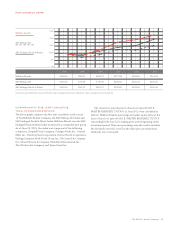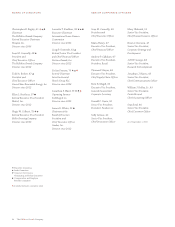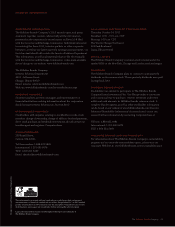Sara Lee 2013 Annual Report Download - page 60
Download and view the complete annual report
Please find page 60 of the 2013 Sara Lee annual report below. You can navigate through the pages in the report by either clicking on the pages listed below, or by using the keyword search tool below to find specific information within the annual report.
58 The Hillshire Brands Company
NOTES TO FINANCIAL STATEMENTS
Valuation allowances have been established on net operating
losses and other deferred tax assets in certain U.S. state jurisdic-
tions as a result of the company’s determination that there is less
than a 50% likelihood that these assets will be realized.
The company records tax reserves for uncertain tax positions
taken, or expected to be taken, on a tax return. For those tax benefits
to be recognized, a tax position must be more-likely-than-not to be
sustained upon examination by the tax authorities. The amount
recognized is measured as the largest amount of benefit that is
greater than 50% likely of being realized upon audit settlement.
Due to the inherent complexities arising from the nature of
the company’s businesses, and from conducting business and being
taxed in a substantial number of jurisdictions, significant judgments
and estimates are required to be made. Agreement of tax liabilities
between Hillshire Brands and the many tax jurisdictions in which
the company files tax returns may not be finalized for several years.
Thus, the company’s final tax-related assets and liabilities may
ultimately be different from those currently reported.
Our total unrecognized tax benefits that, if recognized, would
affect our effective tax rate were $65 million as of June 29, 2013.
This amount differs from the balance of unrecognized tax benefits
as of June 30, 2012 primarily due to uncertain tax positions that
created deferred tax assets in jurisdictions which have not been real-
ized due to a lack of profitability in the respective jurisdictions. At
this time, the company estimates that it is reasonably possible that
the liability for unrecognized tax benefits will decrease by approxi-
mately $5 to $30 million in the next 12 months from a variety of
uncertain tax positions as a result of the completion of various
worldwide tax audits currently in process and the expiration of the
statute of limitations in several jurisdictions.
The company recognizes interest and penalties related to
unrecognized tax benefits in tax expense. During the years ended
June 29, 2013, June 30, 2012 and July 2, 2011, the company recog-
nized a benefit of $1 million, benefit of $3 million and an expense
of $2 million, respectively, of interest and penalties in continuing
operations tax expense. The tax benefits in 2012 and 2013 were the
result of the finalization of tax reviews and audits and changes in
estimates of tax contingencies. As of June 29, 2013, June 30, 2012
and July 2, 2011, the company had accrued interest and penalties of
approximately $8 million, $10 million and $21 million, respectively.
The company’s tax returns are routinely audited by federal, state
and foreign tax authorities and these audits are at various stages of
completion at any given time. The Internal Revenue Service (IRS) has
completed examinations of the company’s U.S. income tax returns
through June 28, 2008. With few exceptions, the company is no
longer subject to state and local income tax examinations by tax
authorities for years before July 2, 2005.
The following table presents a reconciliation of the beginning
and ending amount of unrecognized tax benefits for the years ended
June 29, 2013, June 30, 2012 and July 2, 2011:
June 29, June 30, July 2,
In millions Year ended 2013 2012 2011
Unrecognized tax benefits
Beginning of year balance $74 $«83 $88
Increases based on current
period tax positions –58
Increases based on prior
period tax positions –24 –
Decreases based on prior
period tax positions – (4) (5)
Decreases related to settlements
with tax authorities – (33) (4)
Decreases related to a lapse of
applicable statute of limitation (7) (1) (4)
End of year balance $67 $«74 $83
NOTE 19 – BUSINESS SEGMENT INFORMATION
The following are the company’s two business segments and the
types of products and services from which each reportable segment
derives its revenues.
• Retail sells a variety of packaged meat and frozen bakery
products to retail customers in North America. It also includes
gourmet artisanal sausage and salami products.
• Foodservice/Other sells a variety of meats and bakery products
to foodservice customers in North America such as broad-line
foodservice distributors, restaurants, hospitals and other large
institutions and includes commodity meat products.
The company’s management uses operating segment income in
order to evaluate segment performance and allocate resources, which
is defined as operating income before general corporate expenses;
mark-to-market derivative gains/(losses); and amortization of
trademarks and customer relationship intangibles. Beginning in
2013, the reported operating results for the business segments also
excludes significant items and the impact of businesses that have
been exited or disposed. The business segment results reflect the
above changes for all periods presented. Significant items represent


